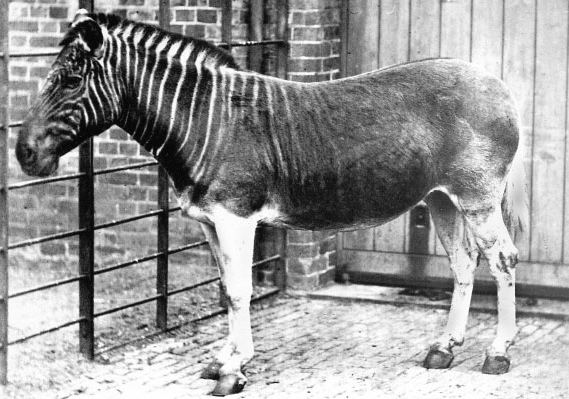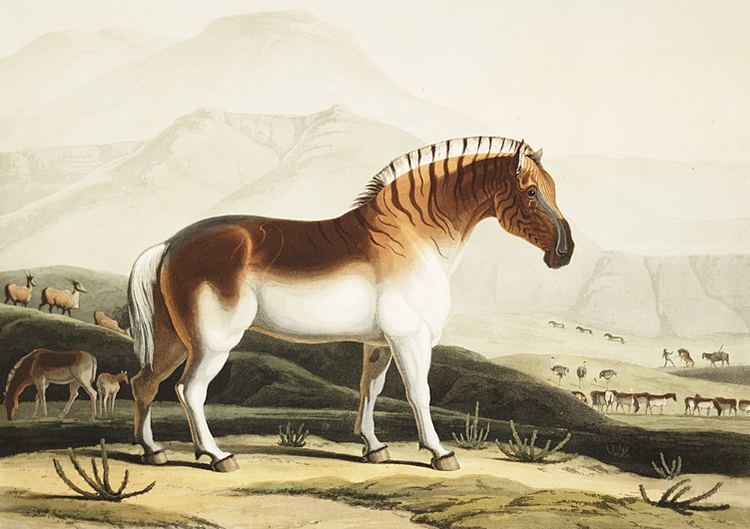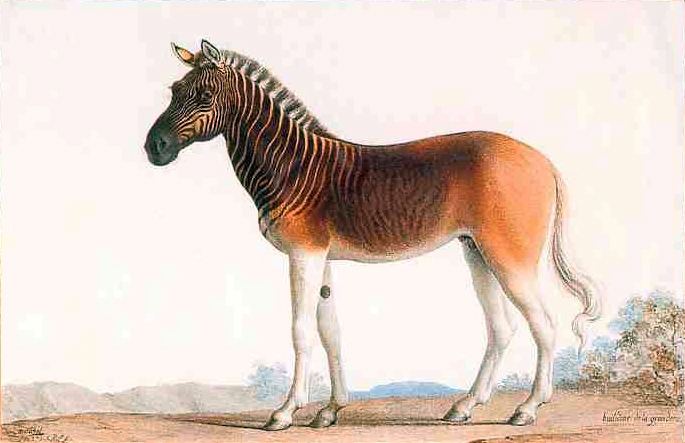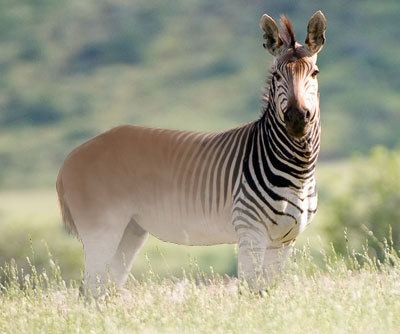Order Perissodactyla Rank Subspecies | Phylum Chordata Scientific name Equus quagga quagga Length 2.6 m (Adult, Estimated) | |
 | ||
Subgenus Hippotigris{{{grandparent authority}}} Height 1.2 – 1.4 m (Adult, At Shoulder, Estimated) Similar Quagga mussel, Equus, Thylacine, Mountain zebra, Javan tiger | ||
The quagga (/ˈkwɑːxɑː/ or /ˈkwæɡə/) (Equus quagga quagga) is an extinct subspecies of plains zebra that lived in South Africa until the 19th century. It was long thought to be a distinct species, but genetic studies have shown it to be the southernmost subspecies of plains zebra. It is considered particularly close to Burchell's zebra. Its name is derived from its call, which sounds like "kwa-ha-ha".
Contents
- 1226 99 animal conservation quagga recreation in south africa
- Taxonomy
- Evolution
- Description
- Behaviour and ecology
- Decline and extinction
- Breeding back project
- References

The quagga is believed to have been around 257 cm (8 ft 5 in) long and 125–135 cm (4 ft 1 in–4 ft 5 in) tall at the shoulder. It was distinguished from other zebras by its limited pattern of primarily brown and white stripes, mainly on the front part of the body. The rear was brown and without stripes, and therefore more horse-like. The distribution of stripes varied considerably between individuals. Little is known about the quagga's behaviour, but it may have gathered into herds of 30–50 individuals. Quaggas were said to be wild and lively, yet were also considered more docile than Burchell's zebra. They were once found in great numbers in the Karoo of Cape Province and the southern part of the Orange Free State in South Africa.

After the Dutch settlement of South Africa began, the quagga was heavily hunted as it competed with domesticated animals for forage. While some individuals were taken to zoos in Europe, breeding programs were unsuccessful. The last wild population lived in the Orange Free State, and the quagga was extinct in the wild by 1878. The last captive specimen died in Amsterdam on 12 August 1883. Only one quagga was ever photographed alive and only 23 skins are preserved today. In 1984, the quagga was the first extinct animal to have its DNA analysed, and the Quagga Project is trying to recreate the phenotype of hair coat pattern and related characteristics by selectively breeding Burchell's zebras.

1226 99 animal conservation quagga recreation in south africa
Taxonomy

The name "quagga" is derived from the Khoikhoi word for zebra and is onomatopoeic, being said to resemble the quagga's call, variously transcribed as "kwa-ha-ha", "kwahaah", or "oug-ga". The name is still used colloquially for the plains zebra. The quagga was originally classified as a distinct species, Equus quagga, in 1778 by Dutch naturalist Pieter Boddaert. Traditionally, the quagga and the other plains and mountain zebras were placed in the subgenus Hippotigris.

There has been much debate over the status of the quagga in relation to the plains zebra. It is poorly represented in the fossil record, and the identification of these fossils is uncertain, as they were collected at a time when the name quagga referred to all zebras. Fossil skulls of Equus mauritanicus from Algeria have been claimed to show affinities with the quagga and the plains zebra, but they may be too badly damaged to allow definite conclusions to be drawn from them. Quaggas have also been identified in cave art attributed to the San. Reginald Innes Pocock was perhaps the first to suggest that the quagga was a subspecies of plains zebra in 1902. As the quagga was scientifically described and named before the plains zebra, the trinomial name for the quagga becomes E. quagga quagga under this scheme, and the other subspecies of plains zebra are placed under E. quagga as well.
Historically, quagga taxonomy was further complicated by the fact that the extinct southernmost population of Burchell's zebra (Equus quagga burchellii, formerly Equus burchellii burchellii) was thought to be a distinct subspecies (also sometimes thought a full species, E. burchellii). The extant northern population, the "Damara zebra", was later named Equus quagga antiquorum, which means that it is today also referred to as E. q. burchellii, after it was realised they were the same taxon. The extinct population was long thought very close to the quagga, since it also showed limited striping on its hind parts. As an example of this, Shortridge placed the two in the now disused subgenus Quagga in 1934. Most experts now suggest that the two subspecies represent two ends of a cline.
Different subspecies of plains zebra were recognised as members of Equus quagga by early researchers, though there was much confusion over which species were valid. Quagga subspecies were described on the basis of differences in striping patterns, but these differences were since attributed to individual variation within the same populations. Some subspecies and even species, such as E. q. danielli and Hippotigris isabellinus, were only based on illustrations (iconotypes) of aberrant quagga specimens. Some authors have described the quagga as a kind of wild horse rather than a zebra, and one craniometric study from 1980 seemed to confirm its affiliation with the horse (Equus caballus). It has been pointed out that early morphological studies were erroneous; using skeletons from stuffed specimens can be problematical, as early taxidermists sometimes used donkey and horse skulls inside their mounts when the originals were unavailable.
Evolution
The quagga was the first extinct animal to have its DNA analysed, and this 1984 study launched the field of ancient DNA analysis. It confirmed that the quagga was more closely related to zebras than to horses, with the quagga and mountain zebra (Equus zebra) sharing an ancestor 3–4 million years ago. An immunological study published the following year found the quagga to be closest to the plains zebra. A 1987 study suggested that the mtDNA of the quagga diverged at a range of roughly 2% per million years, similar to other mammal species, and again confirmed the close relation to the plains zebra.
Later morphological studies came to conflicting conclusions. A 1999 analysis of cranial measurements found that the quagga was as different from the plains zebra as the latter is from the mountain zebra. A 2004 study of skins and skulls instead suggested that the quagga was not a distinct species, but a subspecies of the plains zebra. In spite of these findings, many authors subsequently kept the plains zebra and the quagga as separate species.
A genetic study published in 2005 confirmed the subspecific status of the quagga. It showed that the quagga had little genetic diversity, and that it diverged from the other plains zebra subspecies only between 120,000 and 290,000 years ago, during the Pleistocene, and possibly the penultimate glacial maximum. Its distinct coat pattern perhaps evolved rapidly because of geographical isolation and/or adaptation to a drier environment. In addition, plains zebra subspecies tend to have less striping the further south they live, and the quagga was the most southern-living of them all. Other large African ungulates diverged into separate species and subspecies during this period as well, probably because of the same climate shift. The simplified cladogram below is based on the 2005 analysis (some taxa shared haplotypes and could therefore not be differentiated):
Description
The quagga is believed to have been 257 cm (8 ft 5 in) long and 125–135 cm (4 ft 1 in–4 ft 5 in) tall at the shoulder. Its coat pattern was unique among equids: zebra-like in the front but more like a horse in the rear. It had brown and white stripes on the head and neck, brown upper parts and a white belly, tail and legs. The stripes were boldest on the head and neck and became gradually fainter further down the body, blending with the reddish brown of the back and flanks, until disappearing along the back. It appears to have had a high degree of polymorphism, with some individuals having almost no stripes and others having patterns similar to the extinct southern population of Burchell's zebra, where the stripes covered most of the body except for the hind parts, legs and belly. It also had a broad dark dorsal stripe on its back. It had a standing mane with brown and white stripes.
The only quagga to have been photographed alive was a mare at the Zoological Society of London's Zoo. Five photographs of this specimen are known, taken between 1863 and 1870. On the basis of photographs and written descriptions, many observers suggest that the stripes on the quagga were light on a dark background, unlike other zebras. Reinhold Rau, pioneer of the Quagga Project, claimed that this is an optical illusion: that the base colour is a creamy white and that the stripes are thick and dark. Embryological evidence supports zebras being dark coloured with white as an addition.
Living in the very southern end of the plains zebra's range, the quagga had a thick winter coat that moulted each year. Its skull was described as having a straight profile and a concave diastema, and as being relatively broad with a narrow occiput. Like other plains zebras, the quagga did not have a dewlap on its neck as the mountain zebra does. The 2004 morphological study found that the skeletal features of the southern Burchell's zebra population and the quagga overlapped, and that they were impossible to distinguish. Some specimens also appeared to be intermediate between the two in striping, and individuals of the extant Burchell's zebra population still exhibit limited striping. It can therefore be concluded that the two subspecies graded morphologically into each other. Today, some stuffed specimens of quaggas and southern Burchell's zebra are so similar that they are impossible to definitely identify as either, since no location data was recorded. The female specimens used in the study were larger than the males on average.
Behaviour and ecology
The quagga was the southernmost distributed plains zebra, mainly living south of the Orange River. It was a grazer, and its habitat range was restricted to the grasslands and arid interior scrubland of the Karoo region of South Africa, today forming parts of the provinces of Northern Cape, Eastern Cape, Western Cape and the Free State. These areas were known for distinctive flora and fauna and high amounts of endemism.
Little is known about the behaviour of quaggas in the wild, and it is sometimes unclear what exact species of zebra is referred to in old reports. The only source that unequivocally describes the quagga in the Free State is that of the English military engineer and hunter Major Sir William Cornwallis Harris. His 1840 account reads as follows:
The geographical range of the quagga does not appear to extend to the northward of the river Vaal. The animal was formerly extremely common within the colony; but, vanishing before the strides of civilisation, is now to be found in very limited numbers and on the borders only. Beyond, on those sultry plains which are completely taken possession of by wild beasts, and may with strict propriety be termed the domains of savage nature, it occurs in interminable herds; and, although never intermixing with its more elegant congeners, it is almost invariably to be found ranging with the white-tailed gnu and with the ostrich, for the society of which bird especially it evinces the most singular predilection. Moving slowly across the profile of the ocean-like horizon, uttering a shrill, barking neigh, of which its name forms a correct imitation, long files of quaggas continually remind the early traveller of a rival caravan on its march. Bands of many hundreds are thus frequently seen doing their migration from the dreary and desolate plains of some portion of the interior, which has formed their secluded abode, seeking for those more luxuriant pastures where, during the summer months, various herbs thrust forth their leaves and flowers to form a green carpet, spangled with hues the most brilliant and diversified.
Quaggas have been reported gathering into herds of 30–50 individuals and sometimes travelled in a linear fashion. They may have been sympatric with Burchell's zebra between the Vaal and Orange rivers. This is disputed, and there is no evidence that they interbred. It could also have shared a small portion of its range with Hartmann's mountain zebra (Equus zebra hartmannae).
Quaggas were said to be lively and highly strung, especially the stallions. During the 1830s, quaggas were used as harness animals for carriages in London, the males probably being gelded to mitigate their volatile nature. Local farmers used them as guards for their livestock, as they were likely to attack intruders. On the other hand, captive quaggas in European zoos were said to be tamer and more docile than Burchell's zebra. One specimen was reported to have lived in captivity for 21 years and 4 months, dying in 1872.
Since the practical function of striping has not been determined for zebras in general, it is unclear why the quagga lacked stripes on its hind parts. A cryptic function for protection from predators (stripes obscure the individual zebra in a herd) and biting flies (which are less attracted to striped objects), as well as various social functions, have been proposed for zebras in general. Differences in hind quarter stripes may have aided species recognition during stampedes of mixed herds, so that members of one subspecies or species would follow its own kind. It has also been evidence that the zebras developed striping patterns as thermoregulation to cool themselves down, and that the quagga lost them due to living in a cooler climate, although one problem with this is that the mountain zebra lives in similar environments and has a bold striping pattern. A 2014 study strongly supported the biting-fly hypothesis, and the quagga appears to have lived in areas with lesser amounts of fly activity compared to other zebras.
Decline and extinction
As it was easy to find and kill, the quagga was hunted by early Dutch settlers and later by Afrikaners to provide meat or for their skins. The skins were traded or used locally. The quagga was probably vulnerable to extinction due to its limited distribution, and it may have competed with domestic livestock for forage. The quagga had disappeared from much of its range by the 1850s. The last population in the wild, in the Orange Free State, was extirpated in the late 1870s. The last known wild individual died in 1878.
Individual quaggas were also captured and shipped to Europe, where they were displayed in zoos. Lord Morton tried to save the animal from extinction by starting a captive breeding program. He was only able to obtain a single male which, in desperation, he bred with a female horse. This produced a female hybrid with zebra stripes on its back and legs. Lord Morton's mare was sold and was subsequently bred with a black stallion, resulting in offspring that again had zebra stripes. An account of this was published in 1820 by the Royal Society. This led to new ideas on telegony, referred to as pan-genesis by Charles Darwin.
The last captive specimen, a female in Amsterdam's Natura Artis Magistra zoo, lived there from 9 May 1867 until it died on 12 August 1883, but its origin and cause of death were not recorded. The specimen in London died in 1872 and the one in Berlin in 1875. There are 23 known stuffed and mounted quagga specimens throughout the world. In addition, there is a mounted head and neck, a foot, seven complete skeletons, and samples of various tissues. A twenty-fourth mounted specimen was destroyed in Königsberg, Germany, during World War II.
Breeding back project
After the very close relationship between the quagga and surviving zebras was discovered, Reinhold Rau started the Quagga Project in 1987 in South Africa to create a quagga-like zebra population by selective breeding for a reduced stripe pattern from plains zebra stock, with the eventual aim of introducing them to the quagga's former range. To differentiate between the quagga and the zebras of the project, they refer to it as "Rau quaggas". The founding population consisted of 19 individuals from Namibia and South Africa, chosen because they had reduced striping on the rear body and legs. The first foal of the project was born in 1988. Once a sufficiently quagga-like population has been created, it will be released in the Western Cape.
Introduction of these quagga-like zebras could be part of a comprehensive restoration program including such ongoing efforts as eradication of non-native trees. Quaggas, wildebeest, and ostriches, which occurred together during historical times in a mutually beneficial association, could be kept together in areas where the indigenous vegetation has to be maintained by grazing. In early 2006, the third and fourth generation animals produced by the project were considered looking much like the depictions and preserved specimens of the quagga. This type of selective breeding is called breeding back. The practice is controversial, since the resulting zebras will resemble the quaggas only in external appearance, but will be genetically different. The technology to use recovered DNA for cloning does not yet exist.
